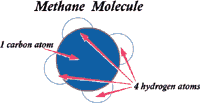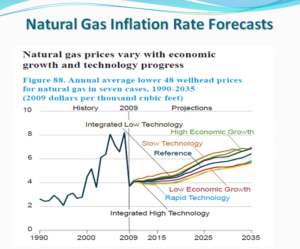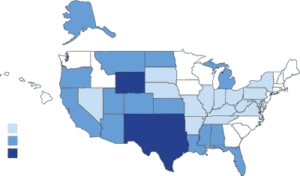Why use Natural Gas for power generation?
Commonly Used. Natural Gas is used as a source of energy to heat water, heat building air space, generate steam, and power internal combustion engines to generate both electricity, cooling or thermal heat for manufacturing plant operations.
Low Emissions. Natural gas is a clean fuel. The main products released when it is burned are carbon dioxide and water vapor. Coal and oil are more chemically complex and, when burned, will release a variety of potentially harmful chemicals into the air.
Inflationary Cost. Natural Gas prices have declined by 66% in the last few years and is projected to inflate at less than 3.0% per year through 2035. This is lower than the utility inflation rates of 5 to 6% over the past decade. Utility rates will inflate at a higher rate than NG costs.
NG Supply. The low projection of inflationary costs is due to the abundant US supply of NG energy which is currently twice that of the entire Saudi Arabia oil supply.
KWH Generation Costs. Because of its low cost, Natural Gas fired co-generation systems can generate electric energy at a lower cost that is 40% to 60% lower than current utility rates (e.g. 3 to 5 cents per KWH versus the current average utility rates of 9 to 14 cents per KWH),
Who provides the Natural Gas normally?
The natural gas is normally provided by your local utility company. As an example, 50% of the residential households receive natural gas from the utility or 3rd party providers, and use approximately 21% of the nation’s consumption of natural gas.
Can I buy my NG from ESD?
ESD is a certified and authorized supplier for Natural Gas Services in your state and can deliver Natural Gas to meet your energy needs. ESD has established a partnership with a preferred Natural Gas supplier that:
Is the 2nd largest provider of low cost Natural Gas in California.
Currently serves 25,000 clients in Northern California.
Reliably delivers over 20,000,000 MMBTU of NG Services every month.
Consistently delivers Natural Gas at a savings over utility rates.
Reflects our “customer first” philosophy of integrity, quality and service.
How will I get my natural gas from ESD?
ESD’s natural gas supplier will deliver the NG through the existing utility company’s gas supply lines, and will bill you for the commodity (gas).
Your utility will charge you for the normal transportation charges, but is now allowed to mark up the cost of the Natural Gas delivered by ESD.
Why should I buy my gas through ESD?
ESD can deliver the same amount of Natural Gas you currently use at a savings.
Our supplier has consistently delivered Natural Gas at a lower price than PGE (32 out of 42 months = 76%).
Our success is based on a “customer first” philosophy of providing integrity, quality and concern for each and every customer.
Who do I call if I have any problems or questions?
Your primary relationship remains with ESD. Your ESD account executive will respond to all calls, answer all of your energy service questions and resolve any issues or problems you may encounter.
Will the quality of gas I receive be the same?
Yes. Natural gas must meet certain standards before it is allowed to enter the transportation pipelines. Once gas is introduced into the pipelines, it is co-mingled with the gas already present so that the quality of the gas you receive on behalf of the utility companies or ESD is indistinguishable.
Who will take care of my gas system?
Your utility company will continue to deliver the energy to your home or business. The utility handles meter reading and repair, gas transportation, line repair and emergency calls. You will never be asked to allow a stranger access to your premises whom you cannot identify as an employee of your utility.
Can ESD shut off my gas?
No. The control of your gas service remains with your utility company. If you lose your supplier for any reason, you will be given 15 days notice to allow you time to choose a new supplier, or by default you will return to the local utility.
Can I decide later to return to the utility?
Yes. If for any reason you decide that you prefer having your gas supplied by the utility, you can switch back, subject to the terms of your contract with your current gas supplier.
Can I be switched from ESD to another supplier without my approval?
No. To minimize the potential for unauthorized switching (a process known as “slamming”), ESD is required to agree to state rules and guidelines for obtaining, maintaining and stopping service. These provisions, copies of which are filed with the state, include a ban against unauthorized switching. Suppliers that slam must pay all costs and fees incurred by the customer and the utility arising from such a switch, as well as any costs to switch the customer back. The state may also impose additional penalties.
Will the utility be upset if I switch to an ESD?
No. Most utilities have programs in place introducing customers to deregulation and promoting the idea of choice in their energy suppliers. They understand that a competitive marketplace should bring about enhanced services and price benefits.
If I use ESD, will I receive two bills?
ESD will work with your utility company to offer you a single bill that covers all monthly consumer charges. There are occasions where two bills may be appropriate for some customers.
What’s in natural gas?
Natural gas found in the ground contains methane, ethane, propane,butane, pentane, and traces of hexane and heptanes. Gas utilities remove almost everything but the methane so the natural gas delivered to your home will burn cleanly.
What is methane?
Methane is a molecule made up of one carbon atom and four hydrogen atoms. Its chemical formula is CH4.
What makes natural gas a clean fuel?
The main products released when natural gas is burned are carbon dioxide and water vapor. Coal and oil are more chemically complex than natural gas, so when burned they release a variety of potentially harmful chemicals into the air.
What is Natural Gas used for?
The heat from the burning of Natural Gas is commonly used to heat water, heat building air space, generate steam, power internal combustion engines or turbines to generate both electricity, cooling or thermal heat for manufacturing plant operations.
Why is natural gas used to run electric power plants?
In the 1970s and 1980s, most electric power plants were fueled by coal or nuclear power. But due to environmental concerns, by the 1990s, about 60 percent of new electric power plant capacity was fueled by natural gas. Today natural gas is the primary energy source for powering new electricity generating plants in the U.S because it is a clean-burning and competitively priced fuel. (Source: American Gas Association)
Is it cheaper to use Natural Gas to generate electricity or thermal heat?
Yes. Natural Gas prices have dropped dramatically by 66% over the past few years from $12 per MMBTU to less than $3.50 per MMBTU in 2012. This drop in cost makes it very competitive for a company to use alternate energy systems, like Natural Gas Fired Co-generation, to generate electricity at a cost under $.05 per KWH versus the utility averages of $.10 to $.20 per KWH, providing a substantial savings of 30% and more.
How large is the US supply of Natural Gas?
The US Natural Gas energy supply is estimated to be twice that of the entire Saudi Arabia oil supply. The combined Energy Information Administration (EIA) and Potential Gas Committee estimates indicate there is a total available future supply of 2,170 Trillion cubic feet, which would equal about 100 years of supply. Americans consume an average of 22 Tcf of natural gas per year.
What is the forecast for Natural Gas price increases?
Natural Gas inflationary costs are forecasted to rise at an average rate of less than 3.0% per year for the next 20 years.
How much of our country’s energy needs are served by natural gas?
Natural gas supplies about 24 percent of all energy used in the United States.
Where in the United States is natural gas located?
Natural gas is found in 33 states. The dark blue states on this map show you where large amounts of natural gas are extracted. In the medium blue states, moderate amounts of natural gas are extracted. And in the light blue states, just a little natural gas is extracted. Natural gas is not extracted at all in the white states.
How much natural gas is produced in the world?
Natural gas is found in about 50 countries. About 2,600 billion cubic meters of natural gas was taken out of the ground and processed for use in 2003. Here is a breakdown of how much of that was produced by various countries and regions:
- United States 21.0%
- Canada 7.0%
- Mexico 1.4%
- Central and South America 4.5%
- Europe and Eurasia 17.0%
- Russian Federation 22.1%
- Middle East 9.8%
- Africa 5.4%
- Asian and Pacific Countries 11.9%
(Source: BP Statistical Review of World Energy 2004)
How much natural gas do we use?
About 2,600 billion cubic meters of natural gas was used in the world in 2003. Here is a breakdown of how much of that was used by various countries and regions:
- United States 24.3%
- Canada 3.4%
- Mexico 1.8%
- Central and South America 4.2%
- Europe and Eurasia 26.1%
- Russian Federation 15.7%
- Middle East 8.6%
- Africa 2.6%
- Asian and Pacific Countries 13.3%
(Source: BP Statistical Review of World Energy 2004)
Why does natural gas smell like rotten eggs?
In its natural state, natural gas has no odor. Utility companies add a chemical odorant called “mercaptan” to natural gas to help make gas leaks easier to notice. If you have a natural gas stove, you may have smelled this rotten egg odor when the pilot light has gone out.
What is “liquefied natural gas?”
When natural gas is cooled to 260 degrees below zero, it changes from a gas into a liquid. Liquid natural gas takes up much less space than natural gas, making it easy to transport and convenient to store. Six hundred cubic feet of natural gas turns into just one cubic foot of liquid gas!
What is a “smart pig?”
A smart pig is an electronic device that can be used to inspect the insides of natural gas pipelines. The device travels through a pipeline and transmits images of the inside of the pipeline so inspectors can tell if the pipeline needs repairs.
How fast does natural gas move through pipelines?
Natural gas travels through pipelines at the slow and steady pace of 15 miles per hour.


